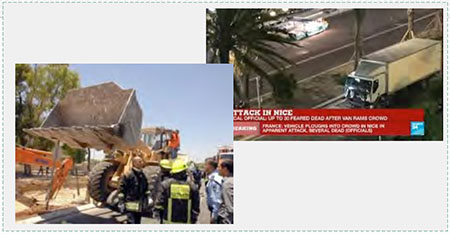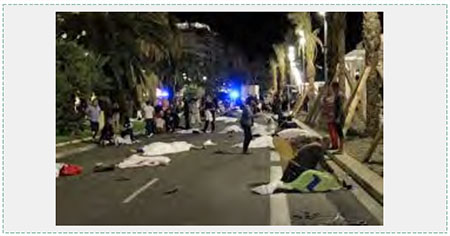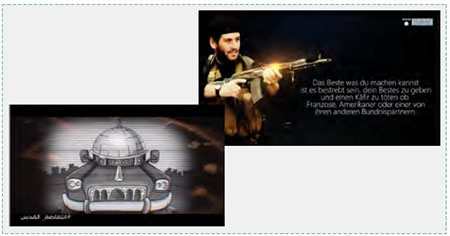
Making vehicular attacks more lethal. Left: Caterpillar front loader used in a vehicular attack in Jerusalem, July 2, 2008. Three people were killed and 70 wounded (Israeli Government Press Office, July 2, 2008). Right: Refrigerator truck used in the terrorist attack in Nice where 84 people were killed and 200 wounded (Twitter, July 14, 2016).
Overview
1. The vehicular attack carried out on the Nice promenade on Bastille Day, July 14, 2016, claimed the lives of 84 people and wounded 200. It was the most lethal vehicular attack ever carried out, no less lethal than most of the other terrorist attacks carried out in Europe during the past year. However, unlike the ISIS attacks, it was relatively simple. It did not demand complex planning or logistics, intelligence collection or deploying a squad of foreign terrorists, as in the terrorist attacks in Istanbul, Brussels and Paris.
2. The vehicular attack in Nice was carried out by a French citizen of Tunisian extraction. He was apparently inspired by ISISbut as far as is known, was not in direct communication with the organization, and did not receive instructions or support from it. Three months ago an ISIS spokesman issued a call to the organization's supporters in France, America and their allies to kill so-called "infidels" in any way possible, including vehicular attacks. On another occasion an ISIS spokesman told its supporters that there were no innocent civilians, and killing civilians was "desirable and beneficial for us because it hurts them [the West] more"(ISIS spokesman Abu Muhammad al-Adnani, May 21, 2016). Claiming responsibility for the attack in Nice, ISIS said it had been carried out by a "soldier of the Islamic State" in response to the call to attack "infidels" where they lived.

The bodies of Nice victims (YouTube).
3. Israel has been dealing with vehicular attacks since the first intifada (1987), most of them carried out by Palestinian popular terrorism operatives who are not organized or directed by the established terrorist organizations. In most instances the Palestinians use ordinary civilian vehicles, but in some cases they have used heavy construction equipment to increase the number of victims. Vehicular attacks continue to this day: since the beginning of the current terrorist campaign which began in September 2015, of the 224 particularly serious terrorist attacks carried out so far, 31 have been vehicular attacks. There have been fewer vehicular than stabbing attacks, but they are more deadly (See Appendix A).

Left: Picture from a Hamas video encouraging vehicular attacks as a way to liberate Al-Aqsa mosque (Facebook page of the Hamas movement in Ramallah and al-Bireh, May 4, 2016) Right: ISIS call in German to kill "infidels," American, French or their allies (Akhbar Dawlat al-Islam, April 16, 2016).
| 4. In ITIC assessment the extraordinary number of victims in the Nice attack and its resonance in global media are liable to lead to copy-cat attacks by ISIS-inspired Muslims in the West and also possibly by Palestinians in Israel. |






